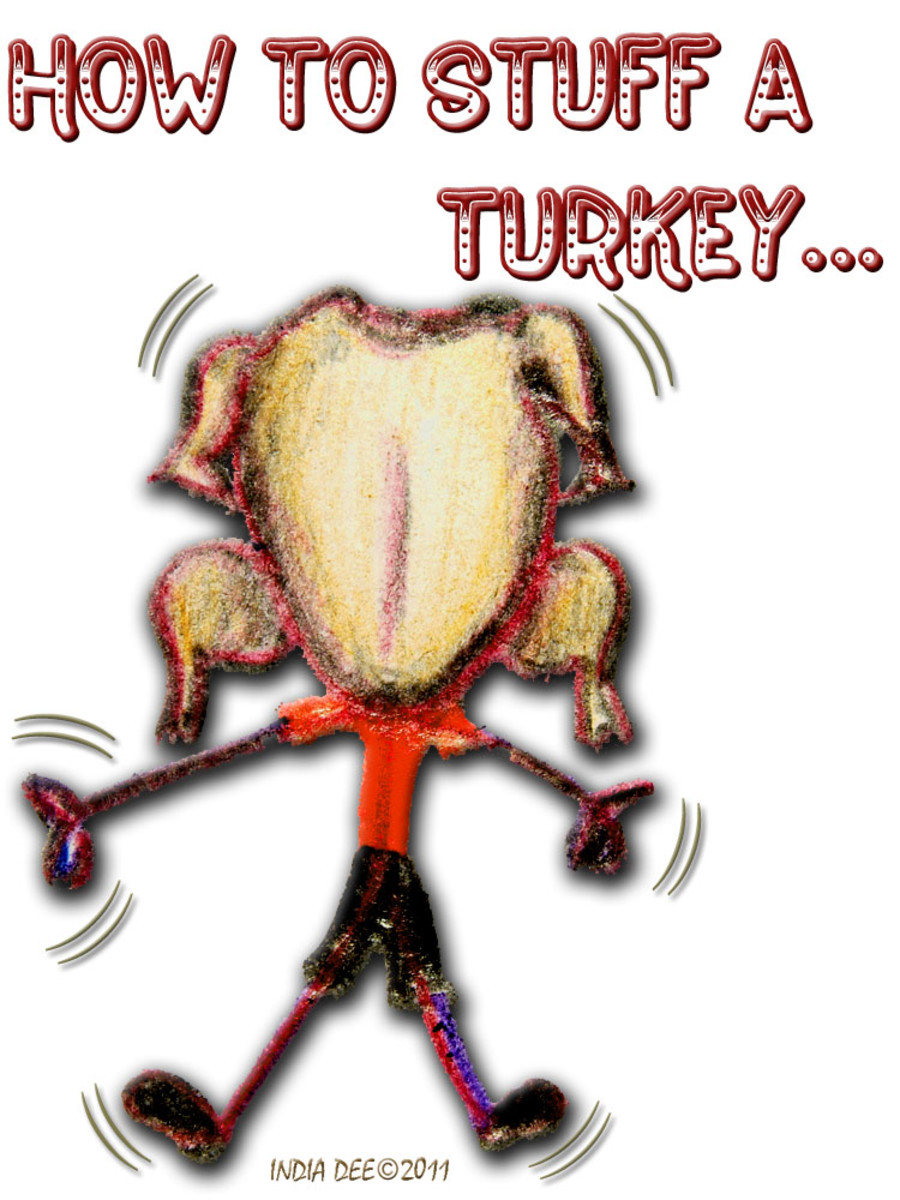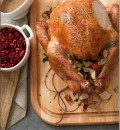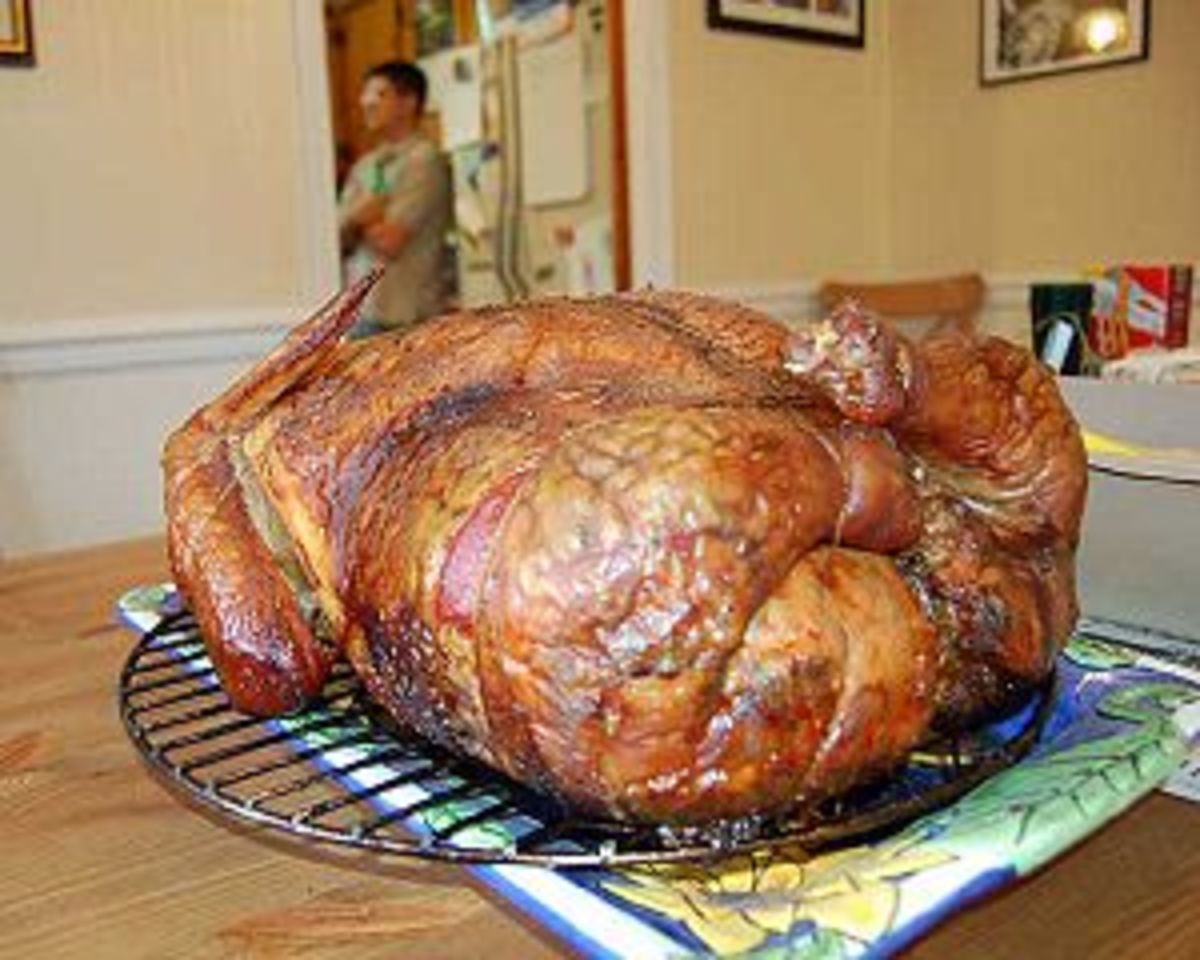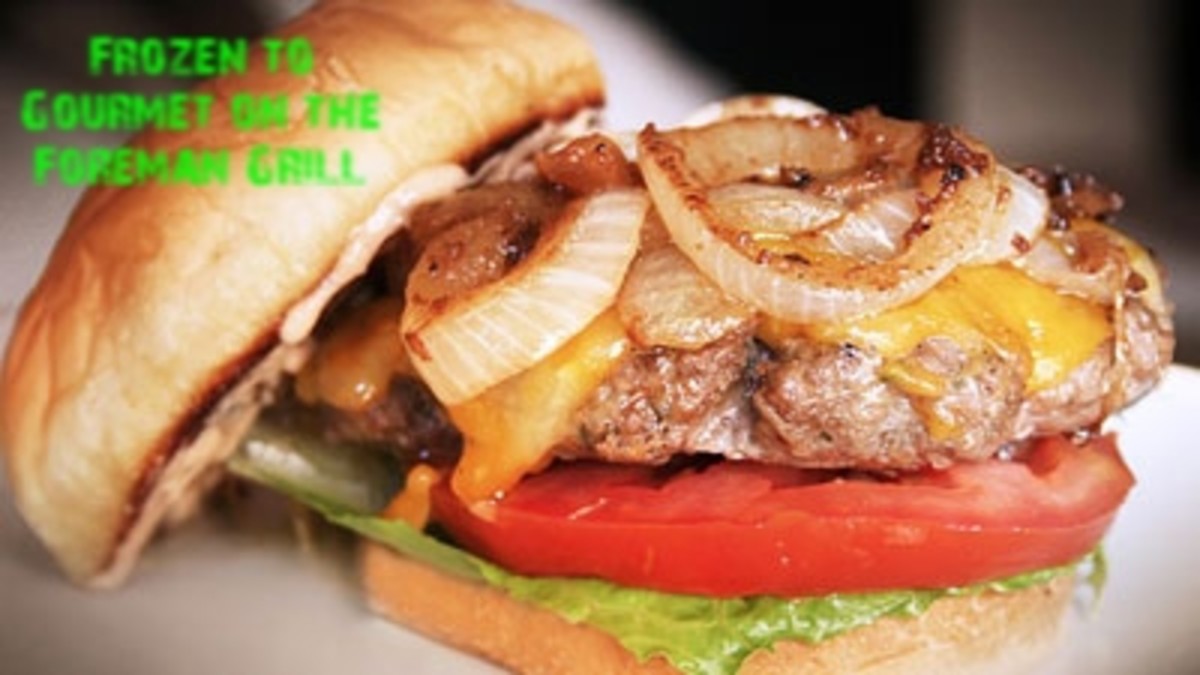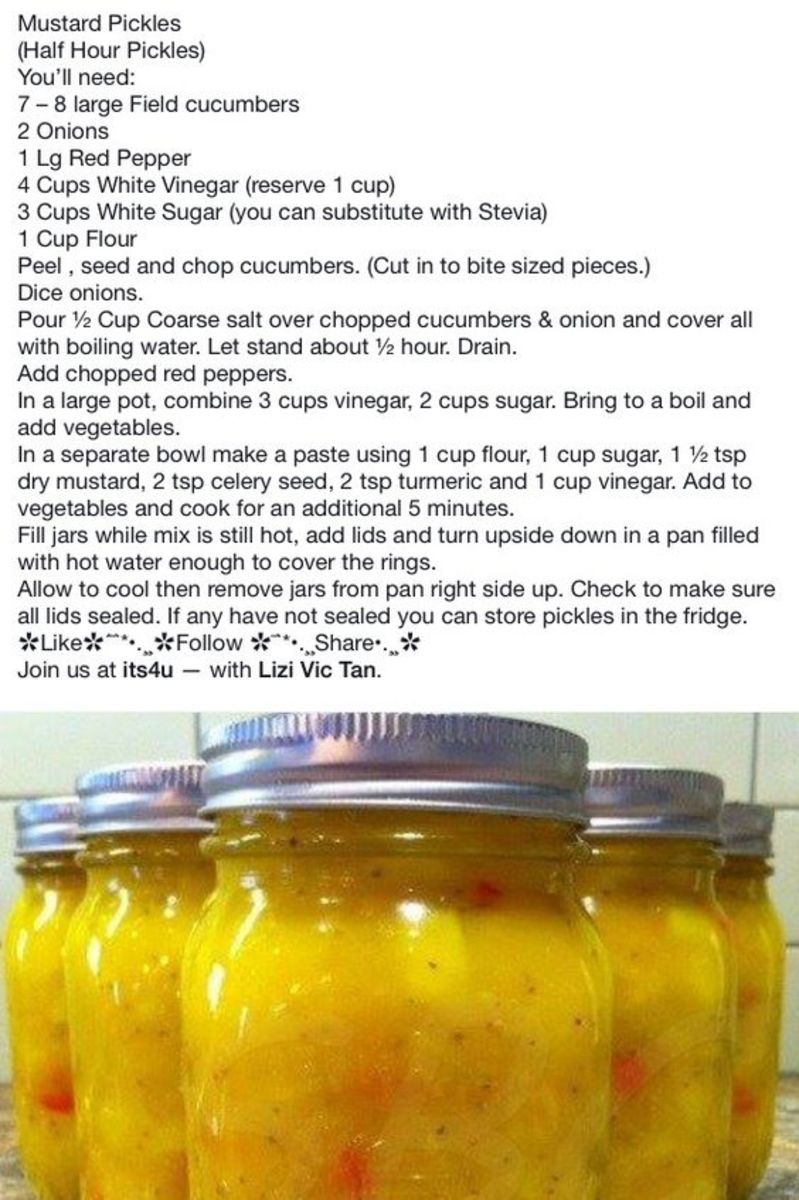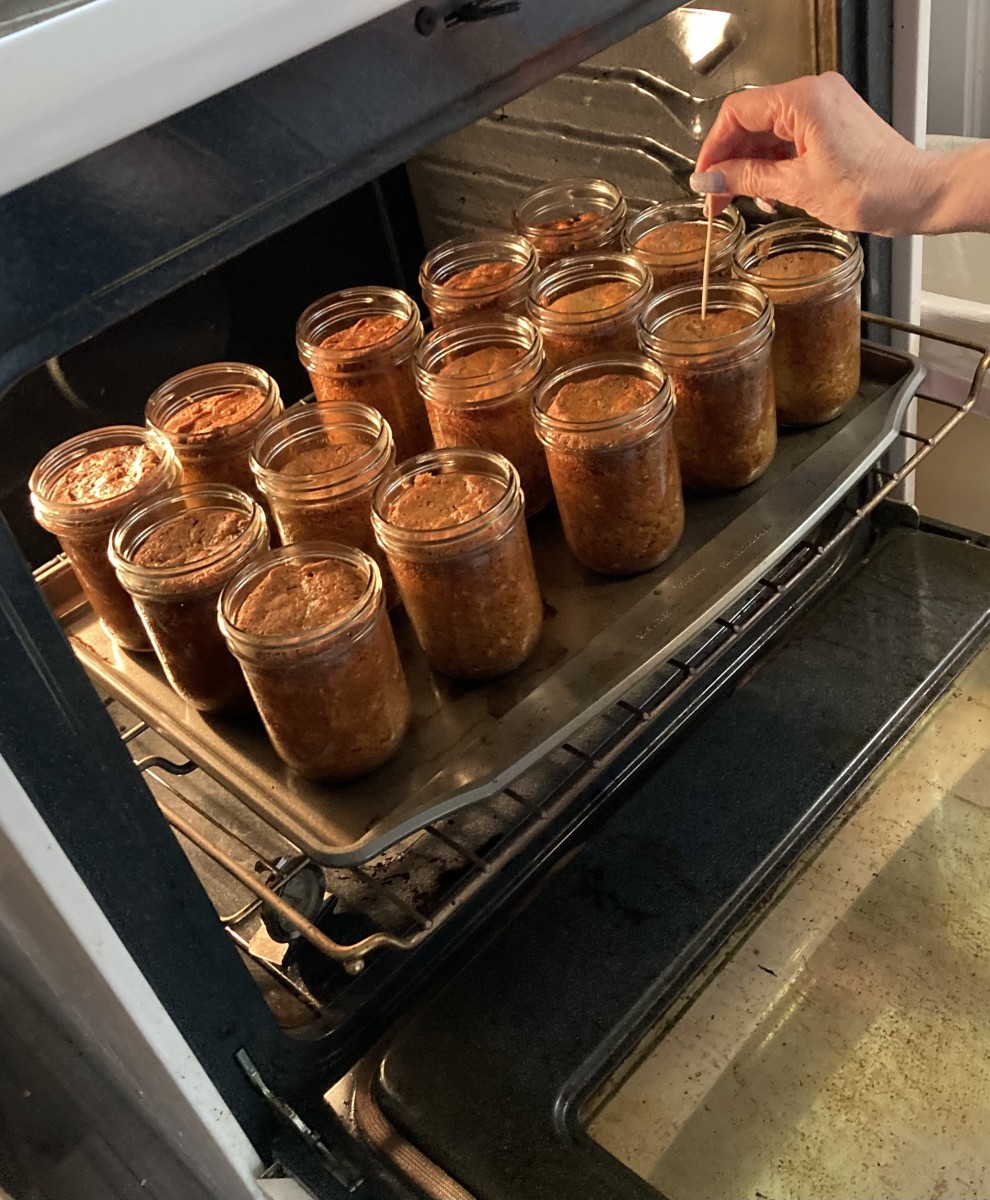Turkey - How to Roast the Perfect Turkey
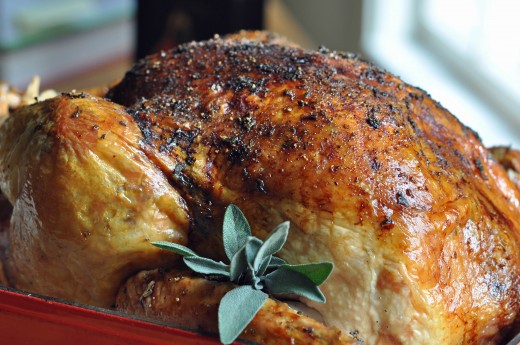
How to Roast the Perfect Turkey
The thought of producing a fabulous turkey - one that is beautiful to behold, sporting a brown crispy skin and a succulent, tender and juicy inside - sends many home cooks into a near panic. It shouldn't! First step? Take a deep breath. Second? Fix yourself a lovely adult beverage, sit back and read through this article. Because it's really not hard to do this - and I'm going to show you how. Better than that, I'm going to give you the 'whys' of the whole turkey thing.
There is a lot of information in this article - but that means there is power here, mon amis! If you understand why things happen, you'll have that much more control over your final product. And control means deliciousness in the end. I'm going to give you Seven Steps to Turkey Nirvana - you can climb the poultry stairway to heaven if you will. And it's a short flight. Not only that, if you choose my own preferred method of roasting your bird, it's also fast, easy, and pretty much hands off. No hours of roasting, no repeated basting, or constantly fiddling with stuffing or other flavors. Just fabulous turkey that will knock your socks off - in under three hours. So you get Bombshell results and STILL get to enjoy your guests! I have a huge family and actually enjoy them - now if you need to hide in the kitchen, feel free to use another method. But mine won't give you that excuse.
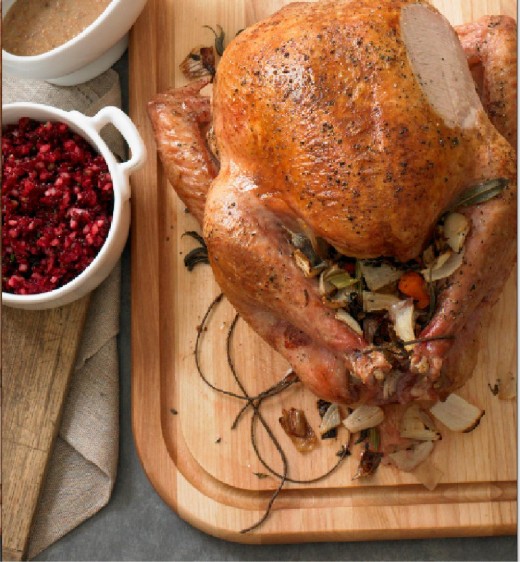
Organic and Free Range Birds
A note of caution:
Organic is listed by the USDA as a farming method free of pesticides and antibiotics. The use of the term organic has become more widely regulated in recent years, and if the label lists the bird as organic, than you're good to go if that's important to you.
However, the term free-range, is far less widely regulated. In order to get this label, the birds must simply have access to the outdoors. The amount of access and the duration is not required - therefore, if the door to the shed is opened for ten minutes a day, and none ever actually go out - then it's still free range. Be careful of thinking your bird was allowed to wander the farm yard at will. I can almost guarantee that didn't happen - unless you know your producer. There are so many quality, ethical farmers out there - make sure they're the ones getting the premium price for that free range bird you're paying for.
Size Matters
It is so tempting to buy the biggest bird you can find - there's just that awesome 'ta-da!' moment when it goes on the table. And I'll admit - I fall prey to that. I'm one of those that thinks the bigger the better - but it's not always so.
You really only need 1 1/2 pounds of whole turkey per person. If you need more than about a 14-18 pound bird, consider making two smaller ones (especially if you want lots of leftovers, and I do). There have been plenty of years I've made three (or more!) smaller birds. I've had one in the oven, one on the smoker and one on the grill more years than I can count. This also allows you to go ahead and carve one for a really pretty serving platter, as well as have a whole one for the 'ta-da!' at the table. I also get a monster bird that I use for Turducken - turkey stuffed with duck stuffed stuffed with chicken. Those are huge - I look for thirty pounds.
The difference? Smaller birds tend to be younger, and therefore far, far more tender. Larger birds are just more of everything - longer defrosting, longer brining, longer cooking times, harder to get accurate internal temperature readings - and the worst part - sometimes too big for a home oven. Don't be afraid if you want the big boys though - just be aware .
Choose the Right Turkey - Step One
The one thing you'll need to do ahead of time is a little thinking. At least a week or two before you plan to present your masterpiece you'll need to decide on step one - which type of turkey to purchase. There are lots of resources out there - fresh, frozen, organic, free range - take your pick.
If you live in an area with lots of retail resources - great! Even better - if you live where there are rural resources - meaning you have access to lots of choices, especially fresh birds, even better. Fresh turkey - never frozen - is my first choice. I don't usually get to make the choice though, since I live in an area without major retail resources, and although we're rural, turkey isn't one of our local products. I have used fresh turkey in the past when I could get them, and they can't be beat. Look for local meat markets, local producers, and upscale grocery stores. In larger areas, regular grocery stores may carry them. If you choose, and you wish to do some hunting ahead of time (store hunting - not out in the woods hunting), you may find yourself with the option of organic and/or free range birds as well as fresh.
Fresh turkey is of course more perishable than frozen birds - hence the planning part. Many stores don't wish to be burdened with a surplus the day after Thanksgiving or Christmas - so they won't stock more than they're sure they can sell. For that reason, fresh birds are sometimes available on a pre-order basis only. You'll need to let your meat counter or producer know you'll want one, and pick it up a day or two (no more, no less) before you'll be roasting it. With all birds - they MUST BE KEPT CHILLED. That'll be a theme through this article - so get used to it. Under 40F - coldest part of your fridge.
For a variety of reasons, most of the time we all end up with frozen turkey however. No big deal - you'll still have terrific results. The trick here is to bring that bird up to temperature slowly and safely. Salmonella isn't nearly the issue here as it was a couple of decades ago - we're all far more aware of food safety, and the production end has improved a million-fold. At the same time however, as I'm writing this nearly three million eggs are under recall in the mid-West. So it pays you back to pay attention here.
The USDA calls the temperature range of 40F-140F the Danger Zone. This is the temperature range at which salmonella and other food borne illnesses can flourish. So it's your job to make sure you limit the time your turkey spends at this temperature as much as possible. So defrost in the refrigerator. Give your bird at least two hours per pound to defrost in the fridge - (and remember this later when you get to the brining stage - this defrosting time is ADDED to the brining time). So the bigger the bird, the further in advance you'll need to pop him out of the freezer and into the fridge. I usually work with birds that are about 14-18 pounds, and I put mine in the fridge three days ahead. I have done birds as big as 30 pounds (especially when I'm going to assemble a Turducken), and those big boys go in up to a week ahead. That's perfectly fine, as long as you're sure of the temperature of your fridge. Grab an inexpensive ($4-5) refrigerator thermometer at the discount store to make sure.
Now - when looking at brands and choices at the store or butcher - keep in mind that your really don't want anything labeled as "pre-basted". These are occasionally labeled "kosher" for some reason (if you know, tell me!). These are packed in a salty solution which serves something of the same purpose as the brine we're going to use. But the taste is far below the untreated birds, and the brine you're going to use will be amazing. Plus the sodium content is through the roof. Just a plain old turkey is what you want. Many of them come with those goofy pop-up timers - I hate those things. But almost all of mine end up having them because of choices here. If you get one, do what I do and just ignore it. (More on that later).
All righty - you've got your bird, and he's defrosted. Next step!
Tryptophan
Don't blame the turkey!
That tryptophan is an essential amino acid - you have to have it, and your body cannot produce it. You have to get it from your diets. All kinds of foods have tryptophan, including cheeses, and tofu. The body uses tryptophan in the production of serotonin, one of the neurotransmitters that regulates healthy sleep patterns.
However, in order to make you sleepy, you'd have to take tryptophan on an empty stomach, and it's very unlikely that you can do that on most holidays. You'd also have to avoid protein - which is what turkey is loaded with. So you'd have to eat tryptophan without eating turkey in order for it to make you sleepy. You want a nap after dinner on Thanksgiving because you're stuffed. That's it. Not the bird's fault.
Setup for Keeping the Turkey Submerged in Brine
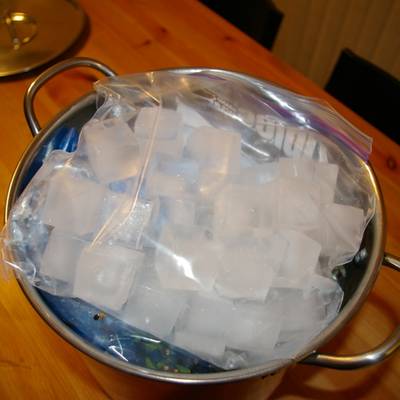
Brining A Turkey - the Importance of Salt - Step Two
If you ask me which is the most important consideration in producing a perfect turkey, I'd be hard pressed to choose between the brine, and the final internal temperature. Those are the two things above all else which will ensure perfect results. Temperature may nudge out brine only because it is possible to have a great bird if you didn't get any planning time - see the text box. But unless there's really, really, good reason - you get in there and brine that bird. You just listen to me. Just do it.
I first encountered brines alongside my grandmother in the kitchen - Southerners have used buttermilk brines for generations for fried chicken. And while the word 'brine' sounds somewhat nautical and therefore piraty and mysterious, it's really just a simple salt water solution. You can still act piraty if you wish. Talk that way if you think it'll help - I sometimes do. Arrrgh.
All you're going to do with a brine is to create a salt water bath in which to soak your turkey. There are countless variations, and feel free to use whichever flavoring agents you wish. But the basic brine is a cup of salt, and a half cup of sugar dissolved in a gallon of water. My favorite also includes a small handful of whole peppercorns, several sprigs of rosemary and thyme and a couple of bay leaves. Other ingredients could include sage, ginger, garlic, onion, apples, brown sugar or molasses – the only limit is your imagination. Just keep in mind that these are the flavors that will subtly appear in your finished product. Brines allow flavoring agents to infuse into the bird itself, and it’s one of the best ways to make sure your poultry is moist and flavorful.
If you have a secret family recipe - or stole one from someone else's family - think of the flavors you use to flavor the bird with that recipe. Mimic those aromatics in the brine. Ditto for dressings (Southerners) or stuffings (Yankees) that you'll serve with the bird. If you go heavy on the sage and onion, use those in the brine. All you have to do is bring all the brine ingredients to a boil in order to release essential oils and dissolve the salt and sugar. Chill the brine well and it's ready to use.
To use the brine you'll need a container just large enough to hold the turkey. I normally use a stockpot or two, although I've called my share of XXL Ziploc bags into use, as well as the occasional cooler - especially for the big boys. Use a large bag of ice to weigh down the bird in order to keep in submerged if you're using a vessel - the turkey needs to stay completely under the brine solution. It also needs to stay very cool - keep in in the cooler or fridge, or if you live in a cold region and the temperature outside will reliably be below 40F, use a cooler outside. I've done both.
Just stick the turkey in the vessel of your choice, and add the chilled brine. Add enough ice and water to the brine to make sure the brine covers the bird, and walk away. For most birds this is 12-24 hours before you intend to cook it. Go make pie. You're ready for the next day....
Didn't Brine? Dang - ok. Here's what to do...
I know I fussed about not skipping the brine - but I understand that LIFE in all it's glory sometimes happens. If you don’t get to prepare far enough in advance to brine, then use a generous rub of good kosher or sea salt on the skin – really rub it in. This will help crisp the skin, while also sealing it so the interior of the bird stays juicy – the same effect brining has. It won’t truly affect the interior to the same degree, but it’s still a great method, and can be done ½ hour before roasting.
How to Brine a Turkey
Bird in the Brine
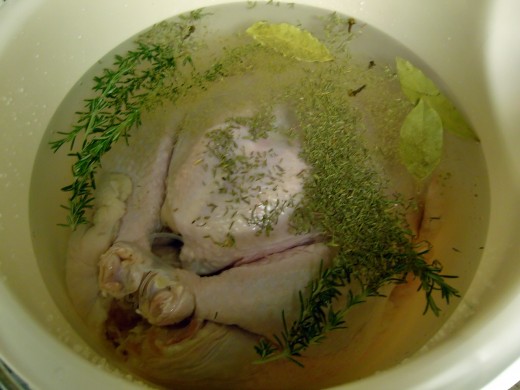
Bird Still Frozen? Well...
If for some reason you didn't end up with a thawed bird, all is not lost. You can still roast it off. A frozen bird can go right in the oven at 350F. You'll have to calculate about 23 minutes per pound (rough estimate - about 50% more cooking time than a thawed bird). Of course you'll need to remove the packet of innards (giblets) once the bird has cooked enough to get it out, and you really won't be able to season it - herbs don't stick to frozen birds. And once it has cooked long enough, you still want an internal temperature of 165F. But you WILL get a roast turkey out of it.
Choose the seasonings...Step Three
Remember that secret family recipe you stole? Quite possibly by being piraty? Here's when you break it out again. Now it's important that you had it in mind in the brining step which flavors you wanted to use throughout. Why?
Because whatever flavors or aromatics you chose when you made your brine are now inside the bird. This means that you need to think of what you want to use now - if you use more sage, you're going to have a much stronger sage flavor. Ditto with everything - garlic, onion, rosemary...whichever you chose. It won't be as strong as doubling up on the seasonings - the primary benefit of having a brine is that the turkey tastes more like turkey. But the ingredients in the brine have now worked their subtle magic through the meat itself, and anything you add at this point will mirror and echo that.
If you wish to use the same flavor base to season with (which is normally what I do), you're going to be just fine. If you want to use something to highlight and contrast, such as honey and chipotle, you'll be wonderful. Just be careful of flavors that might end up too much of a contrast - make sure what you put in your brine works with what you'll use now.
Seasoning at this point is easy - all your going to do is pick out a mirepoix - onion, carrot and celery - and whichever herbs you like. I like to break them into chunks and add them to both the main cavity and the neck cavity. If you wish you can gently loose skin from the meat (careful not to break the skin) and place herbs between the skin and meat. This ends up looking really pretty, especially if you're careful with the placement - the skin crisps and becomes somewhat translucent, allowing the herbs to show. You can also add sprigs or bundles of fresh herbs to the cavity - bunches of parsley, or large sprigs of sage, rosemary and thyme are all classic and absolutely delicious.
What you won't have to do at this point is salt - you've already done that. If you salt now, you'll end up with a bird that is salty, not seasoned. Don't worry about the skin at this point - you'll oil him up in a few minutes, but for now, just make sure he's been patted dry. So once you pull the turkey from the brine, rinse him off really well, and pat him dry with paper towels. Dry skin means crispy brown skin - when the turkey hits the heat of the oven, moisture on the skin would steam, making it far less likely you'll get crispy, golden brown and luscious. So dry that bird off really well. Discard your brine as well - it's simply an invitation to salmonella soup at this point. Never try to save and reuse a brine - that's got Food Safety Issues written all over it. In just another minute you'll be oiling up the bird - but for now, you're ready to move on!
How to Truss a Turkey
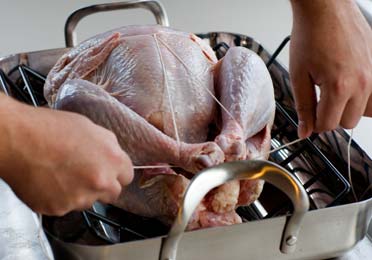
To Stuff or To Dress - The Great Debate - Step Four
I think it's a law that there has to be dressing if there's a turkey - it's just necessary. That fabulous bready stuff is nearly a reason in itself to roast a turkey, and I know of several sit-ins and protests that take place at Thanksgiving or Christmas tables if it isn't done correctly.
There is also a debate over what it's called. In the South it's called dressing - and most of us grew up with it baked off in in it's own dish. Above the Mason Dixon and out West, it's called stuffing, and it's cooked inside the bird or in the same pan (although there's usually some in it's own dish as well). I was firmly in the dressing camp for most of my life, simply because I had honestly never tasted stuffing done inside the bird, and I couldn't imagine that it would be that much better than my Granny's cornbread and sausage dressing.
Then I put together a Turducken, and used a cornbread stuffing in between each layer. The result was one of the most amazing things I've ever tasted - the stuffing was redolent of all those amazing poultry juices - and dang all mighty was that good. Although as a born and bred Southerner I cannot ever betray my culinary heritage, I can certainly embrace the good things - and stuffing a bird is one of those good things.
There are some additional things to keep in mind if you're going to stuff though. Most of the time I don't - or I roast a second small bird with stuffing, and keep one without. Stuffing the bird will affect how much pan drippings you'll end up with. After all, the breads in stuffing is meant to absorb those juices, and those pan drippings are critical to making gravy. So be prepared to lose some or all of that.
Secondly, all the ingredients in stuffing need to be fully cooked before you stuff the bird with them. You're going to roast the turkey until the turkey is done - if you keep cooking long enough for the heat in the stuffing to get high enough for long enough to actually cook the ingredients of the stuffing, your bird will be a toasted mess - far overcooked. With that said, you will need to make sure the stuffing itself does come to temperature - 165F - this is a food safety thing. Stuffed birds harbor more risk of food borne illness because the stuffing did absorb the raw poultry juices. So that needs to be hot enough to make sure you're not serving salmonella with the yummy stuff.
When you place the stuffing in the cavity of the bird, make sure you don't pack it in there tightly. You need to make sure that anything in the cavity is still somewhat loose. Yes, you'll have extra stuffing. You can either bake it off alongside in a separate buttered casserole dish, or use it as a bed on which to roast the turkey (I've done both. Delish). But don't pack the stuffing inside the bird too tightly. That causes it to take longer to come up to a safe temperature, which in turn leads to the bird itself to over cook.
Whichever way you decide to go - your bird is now ready for the roasting pan. If you have a standard roaster with a rack, great! Use it! I don't - I use a very sturdy baking sheet with a rim. The rack in a roaster is designed to keep the bird elevated off the juices, allowing more of the skin to crisp. So if you don't have one - make your own. (This is also a great trick for making some of the best gravy in the world). Lay out several carrots, several stalks of celery and a couple of wedged onions on the baking sheet - the turkey will rest on top of these - so the vegetables create a rack. In addition, the veggies will roast and become one with the drippings, which makes for an amazing flavor - that's a secret for unbelievable gravy. Shhh. True - as they cook they will collapse some, so the very bottom of the bird won't be as crispy, but the gravy makes up for that. Trust me.
Once you have the pan ready, pop the bird on and truss it up. Trussing is just using butcher's twine to make the bird into a more compact package - it will cook more evenly. The wings and legs won't overcook as quickly if they aren't sticking out all over the place. There are all kinds of instructions out there for how to truss a turkey - but all you really have to do is tie him up. I have to admit my knot tying skills are not very strong, and mine usually looks like a Cub Scout went a little nuts trying for a badge. No big deal - it tastes good. Run the twine under the back, loop it over the top and capture the wings, cross it and come back around the legs. Tie it off - that's it. Don't stress.
At this point, all you need is a drizzle of vegetable oil over the skin. If you roast off the bird with a high starting temp, don't use olive oil or butter. They'll break down in the high heat and the flavors won't be pleasant. Vegetable oils have a higher smoke point, so you're safe with those. If you're using no higher than 350F for the duration of the cooking time, than go ahead with whatever fat you like. Good to go. Next!
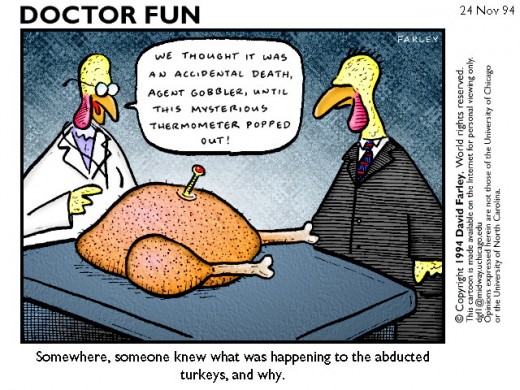

Roasting and Temperature - Steps Five and Six
This is really the easy part - there are a couple of ways you can go here. The first is the seemingly easier method - - set your oven to 350F, pop the turkey in and leave it alone. You are allowed to look through the door, but don't worry about basting it to death. Toward the end of the cooking time, you'll want to check the skin for color. If it's getting too dark, loosely tent the bird with foil and allow it to continue. This is the way you want to go if you have seasonings that are more delicate - butter, honey or brown sugar, or fresh herbs that will burn in higher heat.
However, there is another way to go that is even easier, and more under your control. This is the way I do it almost every single time (the exception being a honey butter glazed turkey). In this second way, you start with the oven rockin' hot - crank it all the way up to 500F. Don't panic - you're only going to leave it there for half an hour. Once the oven is fully preheated, place the turkey and roasting pan in the oven and close the door. Set the timer for thirty minutes. What's going to happen is the skin will begin to truly crisp, and will set and help seal in the juices. After twenty minutes, give it a quick peek to make sure the skin isn't getting too dark. If it is, give it a loose foil tent, and let it keep going.
After the thirty minute period reduce the oven temperature to 350F and let it keep going. Forget about basting - it's not necessary. The brine 'bastes' the turkey from the inside - and since the skin is already lovely, basting doesn't do a thing but release heat from the oven. In general, a turkey needs about 15 minutes per pound - so you can use this number to determine roughly how long the roasting time will take. But starting out at the higher heat will significantly reduce this amount of time, and you're not going to rely on that in any case. There are just too many variables for it to be accurate.
What you ARE going to rely on is a good meat thermometer. You want an internal temperature of 165F for the thickest part of the thigh - place it in the spot right behind the thigh called the 'oyster' (and for any stuffing as well). With the thermometer in place, you don't need to deal with anything else. Oven temperatures and accuracy, the temperature and size of the bird and any stuffing will all change the roasting time - so forget about time charts. The best method is temperature - the method that insures the bird is perfectly cooked, juicy and tender, and absolutely safe. In the case of 12 pound bird you're looking at a total time of 2 1/2 to 3 hours, if you start at 500F and reduce to 350F.
Matter of fact - if you choose to use another cooking method - smoking, grilling or frying you're still going for a temperature reading of 165F instead of a total cooking time, and for the same reasons. Going for internal temperature removes the variables from the turkey equation, and puts control of the results right back in your hands.
Now many birds come with one of those little pop-up timers. Ignore the pop-up! The pop up is really inaccurate - and it's set too high. If you wait on the pop up timer to do it's thing, you'll have well cooked dark meat, but the white meat will be overdone and dry. That thing will only break your heart. It looks good, but don't trust it - it's a bad relationship waiting to happen. Don't worry about removing it - then you'll have a pre-made hole for juice to escape. Just leave it there and pretend you don't see it.
All righty then - your thermometer reads 165F in both the thigh and stuffing - take the bird out and place it on the counter. Almost there...!
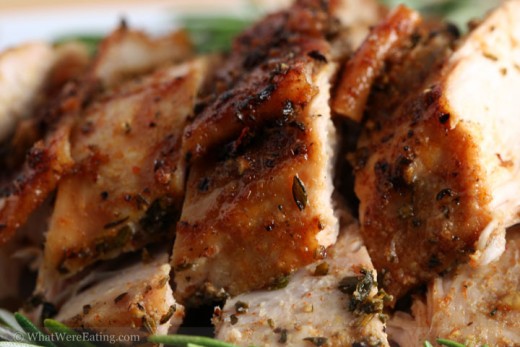
Resting! Step Seven!
It is absolutely critical to let the bird rest when it comes out of the oven. Think of the resting time as just as important as having the bird reach a safe temperature. Don't skip it - you'll be well rewarded for letting it happen. A couple of different things are going on during this resting phase, and you want to take advantage of them.
The first is a phenomena known as 'carryover cooking'. Once you take the bird from the oven, the internal temperature will actually continue to rise. This is fine - don't worry about it. You may gain as much as ten degrees - keep an eye on the thermometer and check it out. You've taken this increase in temperature into consideration, so it's good. Once the carryover temperatures have peaked, the second cool thing starts.
All the juices in the bird rushed to the surfaces of the meat during the heat of cooking. That's all right - they belonged there then. But before you serve it, you want those juices back inside the meat - where they'll make you look awesome when you serve the turkey. If you cut or carve the bird before the resting, you'll end up with a platter full of juice and a bunch of dry turkey. If you allow a good twenty minutes of resting after the temperature has peaked, the juices will have a chance to redistribute back throughout the meat. Think of the turkey as having had a hard workout - give it a chance to recover before you ask it to give its final performance for you.
There you go. Seven Steps to Turkey Nirvana. I know the article was long - but I believe in letting you know WHY things happen. Once you know what the rules are, you'll know which rules you can break, and which ones will break you. But walk the steps with your next bird, and you'll be absolutely Bombshell. I promise. PIRATE promise.
- The Thrillbilly Gourmet
Combining classic technique with everyday food for spectacular results!


